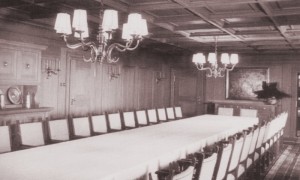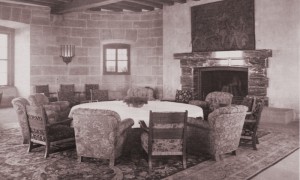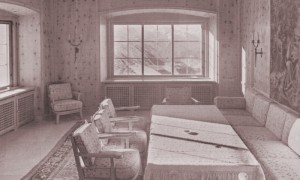For Martin Bormann, the Kehlsteinhaus had been built to make a clear and obvious impression, and if the views of the surrounding mountains were not impressive enough all efforts were made to create just as memorable an atmosphere both inside and around the mountaintop chalet.
Having exited the brass elevator capsule into the entrance atrium, visitors would be whisked through a solid red marble-lined door into the sumptuous wood-lined formal dining hall – the centrepiece of which was the large wooden table able to accommodate up to thirty diners – and from there down a short flight of stairs into the main reception hall.
The large octagonal reception hall was primarily designed for more informal after-dinner entertainment, offering visitors what was almost a 270 degree view of the surrounding mountains and valleys. The floor of the room was laid with an decorative oriental-design carpet that had been presented as a gift to Hitler by the Japanese Emperor Hirohito, while the central feature of the room was the striking fireplace made of high-grade red Carrara marble, presented to the Führer by Italian leader Benito Mussolini. On the southern side of the reception hall another short flight of stairs led to what was arguably the most perfectly situated room in the house, the Scharitzstube.
Also known as the Scharitzkehlzimmer or more recently as the “Eva Braun room”, the Scharitzstube was the brightest room in the house. Lined with expensive Cembra or Swiss pine panelling, the room featured two large picture windows facing south and east, offering a stunning view of the Scharitzkehlalm – after which the room had been named – as well as the Königssee and the peaks of the Hohen Göll and Watzmann. Both of the windows could be lowered almost completely, offering a completely unobstructed view outside.
One would exit the Scharitzstube from its eastern door to reach the long low-walled sun terrace, which provided a stunning picture-postcard view of the Königssee and surrounding mountains through a series of five wide open arches. The open arches left the terrace exposed to the at times inconsiderate mountain climate and were particularly vulnerable to snow during the winter months, but the architect’s decision had clearly been driven by the obvious payoff offered by the unobstructed view below.
Fixtures, Fittings and Furniture
As well as the building itself, Bormann would oversaw the interior design and the purchase of fittings and furniture – in fact, everything was covered up to and including the last cup, saucer and spoon. A massive inventory was drawn up, with everything being put in place: the large table ordered for the dining room came with thirty leather-backed chairs, and a collection of informal tables and pieces of soft furniture were ordered for the main reception hall.
All of the rooms in the Kehlsteinhaus were furnished to the highest standard, with no expense spared or corner cut. The interior decoration was a cumulative process with items being added to the inventory up until 1942, the most expensive of which were the two large tapestries that were hung in the main reception hall and Scharitzstube (they can be seen in the two photographs above) and an exclusive Savonnerie rug set down in the dining room. The cost of both of these items would amount to over a hundred thousand Reichsmarks (around €420,000, £370,000 or $550,000 today), while the large 18m² white linen tablecloth hand-made to order by the Munich-based company Diesz would cost 2,600 RM – equivalent to around €11,000 (£9,600 or $14,000).

Seating up to thirty people, the main dining table was covered in a hand-made 9m by 2m linen tablecloth
The kitchen – which would never be used – was fully equipped with high-grade equipment designed by the Krefft concern, while there was a 750-piece silver cutlery set crafted by Munich-based F. A. Wandiger and 450-piece porcelain dining set made by Germany’s finest and most famous manufacturer Meissen. Every piece of cutlery – including an additional two-dozen tomato knives purchased in 1939 – carried the distinctive “AH” monogram, which would make them prize trinkets when the house was ransacked by occupying Allied troops in 1945.
The Kehlsteinhaus had no permanent residents and had been designed to accommodate only day visitors, who would have usually stayed at the Berghof on the Obersalzberg. Guards may well have slept in the guard room or basement when on overnight duty, but the house had not been equipped with any sleeping facilities.



